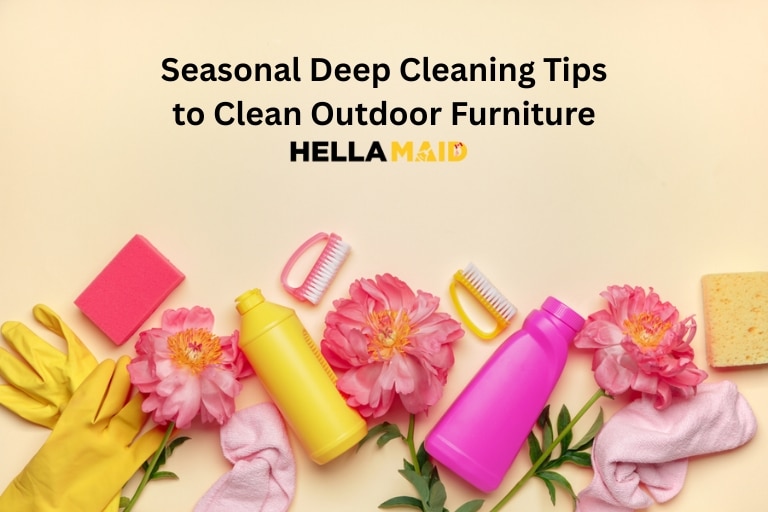Outdoor furniture plays a central role in creating comfortable, functional, and inviting outdoor spaces. However, because it lives outside year-round, it is constantly exposed to elements like sunlight, rain, dust, pollen, and even pests. Without proper maintenance, these conditions can quickly wear down even the most durable materials.
With over five years of experience in the professional cleaning industry, I’ve seen many homeowners struggle with keeping their outdoor furniture in good condition season after season. The good news is, a thoughtful seasonal deep cleaning routine can prevent long-term damage, preserve the look and functionality of your furniture, and save you money on repairs or replacements.
This guide walks you through how to care for different materials and outlines best practices for each season. The advice here is practical, safe, and based on proven cleaning methods used by professionals.
Why Seasonal Cleaning Matters
Outdoor furniture is built to withstand harsh conditions, but it isn’t maintenance-free. Each season brings unique challenges that can cause wear and tear. Seasonal cleaning isn’t just about appearances, it’s about protecting your investment. Whether you maintain everything yourself or work with trusted cleaning services Calgary, staying ahead of seasonal upkeep helps prevent long-term damage. It keeps your outdoor space looking its best.
Key benefits of seasonal cleaning include:
- Preventing mould, mildew, and rust buildup
- Protecting finishes from UV and moisture damage
- Maintaining comfort and hygiene for your family and guests
- Extending the overall life of your outdoor furniture
Rather than waiting until furniture looks dirty, building seasonal cleaning into your routine ensures that problems are addressed before they become permanent.
Spring: Removing Winter Residue and Prepping for Use
Spring is the best time to perform a deep clean. Your furniture has likely collected dust, grime, moisture buildup, and possibly mould during the winter months. This is the time to reset and prepare everything for warmer weather.
Steps to Follow:
- Inspect for Damage:
- Before you begin cleaning, check for loose screws, cracks, rust, or mildew. Early detection means easier fixes.
- Dry Brushing and Dusting:
- Use a soft-bristled brush or microfiber cloth to remove cobwebs, dirt, and plant debris.
- Material-Specific Cleaning:
- Wood (Teak, Acacia, Eucalyptus):
- Clean with a solution of warm water and mild dish soap. Use a soft brush, working along the grain. Avoid power washers, which can damage the wood surface. Once dry, consider applying a teak oil or wood sealant to help preserve its colour and protect it from moisture.
- Metal (Aluminum, Iron, Steel):
- Clean with a mixture of warm water and mild soap. For rust spots, a paste of baking soda and water applied with a soft brush can help. After rinsing and drying, use a rust-resistant spray or protective wax.
- Plastic and Resin:
- Use a solution of dish soap, water, and a splash of white vinegar. For tougher stains, a baking soda paste works well. Avoid harsh abrasives or bleach, which can degrade plastic surfaces over time.
- Fabrics and Cushions:
- If your cushion covers are removable, wash them according to the care label. Spot clean using mild soap and warm water. Let them dry completely in sunlight to prevent mildew growth.
- Let Everything Dry Completely:
- Moisture left on surfaces can lead to mould or corrosion. Always allow time for proper drying after cleaning.
Summer: Routine Maintenance and UV Protection
During summer, outdoor furniture gets the most use, which means it also gets dirtier faster. Sunscreen, food spills, drinks, and sweat can all stain or degrade materials. At this stage, your focus should shift from deep cleaning to light, regular maintenance.
Maintenance Tips for Summer:
- Wipe down surfaces weekly using a damp cloth and mild soap.
- Store cushions when not in use, especially during storms or long stretches of sun.
- Apply a UV protectant spray to plastic and metal surfaces to reduce sun damage.
- Use breathable furniture covers when the furniture isn’t in use for extended periods.
For more about how UV rays affect outdoor surfaces, the Environmental Protection Agency (EPA) has published helpful insights on UV radiation protection.
Fall: Deep Clean and Prepare for Storage
As the weather cools and the outdoor season winds down, this is the right time to prepare furniture for fall rains or winter storage. A proper deep clean before storage helps prevent mould, staining, and unpleasant odours when it’s time to bring the furniture back out.
Steps to Follow:
- Repeat a thorough clean similar to your spring routine.
- Ensure all pieces are dehydrated before storing or covering.
- Apply a final protective layer, such as wood sealant or rust inhibitor, to prevent damage during the wet or cold months.
- Store soft furnishings like cushions and fabric covers in a dry, ventilated place indoors.
- If leaving furniture outdoors, cover it with weather-resistant but breathable covers to avoid moisture buildup underneath.
Avoid storing furniture in airtight plastic wraps, which can trap condensation and encourage mould growth.
Winter: Protecting Furniture in Harsh Conditions
In winter, your goal is to protect furniture from extreme cold, moisture, and snow. Whether you live in a snowy region or just expect cooler, wetter weather, protective storage is key.
Winter Care Tips:
- Move furniture to a garage, shed, or under a covered patio where possible.
- Elevate furniture off the ground to prevent water damage from pooling or snowmelt.
- For pieces that must stay outside, use waterproof furniture covers with ventilation features to allow airflow.
- Place silica gel packs or other moisture absorbers under covers to minimize condensation.
If you’re unsure how cold temperatures might affect outdoor materials like plastic or metal, the National Weather Service offers guidance on cold-weather safety.
Safe and Effective Homemade Cleaning Solutions
If you prefer natural or DIY options, here are a few simple recipes that are effective and safe for most outdoor materials:
- General Cleaner:
- Mix 1 gallon of warm water with 1 tablespoon of mild dish soap and 1 cup of white vinegar. Safe for wood, plastic, and metal.
- Mould and Mildew Spray:
- Combine 2 parts water with 1 part hydrogen peroxide in a spray bottle. Spray on mildew-prone areas and scrub gently after 10 minutes.
- Rust Remover:
- Mix baking soda with a small amount of water to create a paste. Apply to rust spots on metal and gently scrub with a soft brush.
Always test these solutions on a small hidden area before applying them to the entire surface.
Final Thoughts
Taking care of your outdoor furniture doesn’t have to be complicated or time-consuming. By following a seasonal deep cleaning and maintenance schedule, you can protect your furniture from damage, extend its life, and create a clean, comfortable outdoor environment for your family and guests.
The key is consistency. A little effort at the beginning and end of each season can prevent expensive repairs or replacements down the line. Most importantly, it allows you to enjoy your outdoor spaces without worry.
For homeowners looking for professional support, Hellamaid offers trusted residential cleaning services across several regions in Canada, making seasonal upkeep easier than ever.













